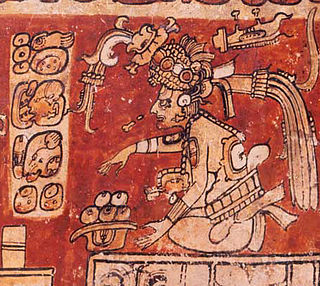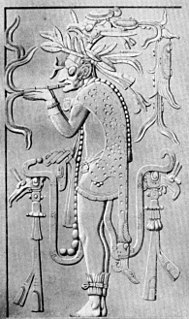Related Research Articles
Maya or Mayan mythology is part of Mesoamerican mythology and comprises all of the Maya tales in which personified forces of nature, deities, and the heroes interacting with these play the main roles. The myths of the Pre-Hispanic era have to be reconstructed from iconography. Other parts of Mayan oral tradition are not considered here.

Kʼawiil, in the Post-Classic codices corresponding to God K, is a Maya deity identified with lightning, serpents, fertility and maize. He is characterized by a zoomorphic head, with large eyes, long, upturned snout and attenuated serpent tooth. A torch, stone celt, or cigar, normally emitting smoke, comes out of his forehead, while a serpent leg represents a lightning bolt. In this way, Kʼawiil personifies the lightning axe both of the rain deity and of the king as depicted on his stelae.

Itzamna is, in Maya mythology, an upper god and creator deity thought to reside in the sky. Itzamna is one of the most important gods in the Classic and Postclassic Maya pantheon. Although little is known about him, scattered references are present in early-colonial Spanish reports (relaciones) and dictionaries. Twentieth-century Lacandon lore includes tales about a creator god who may be a late successor to him. In the pre-Spanish period, Itzamna was often depicted in books and in ceramic scenes derived from them. Before the names of the Maya deities were deciphered, Itzamna was known as "god D", and is still sometimes referred to as "god D" by archeologists.

Bacab is the generic Yucatec Maya name for the four prehispanic aged deities of the interior of the earth and its water deposits. The Bacabs have more recent counterparts in the lecherous, drunken old thunder deities of the Gulf Coast regions. The Bacabs are also referred to as Pauahtuns.

Ixchel or Ix Chel is the 16th-century name of the aged jaguar goddess of midwifery and medicine in ancient Maya culture. She corresponds, more or less, to Toci Yoalticitl "Our Grandmother the Nocturnal Physician", an Aztec earth goddess inhabiting the sweatbath, and is related to another Aztec goddess invoked at birth, viz. Cihuacoatl. In Taube's revised Schellhas-Zimmermann classification of codical deities, Ixchel corresponds to the Goddess O.

Chaac is the name of the Maya rain deity. With his lightning axe, Chaac strikes the clouds and produces thunder and rain. Chaac corresponds to Tlaloc among the Aztecs.

Maximón, also called San Simón, is a Mayan deity and folk saint represented in various forms by the Maya peoples of several towns in the Guatemalan Highlands. Oral tradition of his creation and purpose in these communities is complex, diverse, and born of the ancient Maya traditions centuries ago.
The traditional Maya religion of the extant Maya peoples of Guatemala, Belize, western Honduras, and the Tabasco, Chiapas, Quintana Roo, Campeche and Yucatán states of Mexico is part of the wider frame of Mesoamerican religion. As is the case with many other contemporary Mesoamerican religions, it results from centuries of symbiosis with Roman Catholicism. When its pre-Hispanic antecedents are taken into account, however, traditional Maya religion has already existed for more than two and a half millennia as a recognizably distinct phenomenon. Before the advent of Christianity, it was spread over many indigenous kingdoms, all with their own local traditions. Today, it coexists and interacts with pan-Mayan syncretism, the 're-invention of tradition' by the Pan-Maya movement, and Christianity in its various denominations.

Ancient Maya art is the visual arts of the Mayan civilization, an eastern and south-eastern Mesoamerican culture made up of a great number of small kingdoms in present-day Mexico, Guatemala, Belize and Honduras. Many regional artistic traditions existed side by side, usually coinciding with the changing boundaries of Maya polities. This civilization took shape in the course of the later Preclassic Period, when the first cities and monumental architecture started to develop and the hieroglyphic script came into being. Its greatest artistic flowering occurred during the seven centuries of the Classic Period.
Vucub-Caquix is the name of a bird demon defeated by the Hero Twins of a Kʼicheʼ-Mayan myth preserved in an 18th-century document, entitled ʼPopol Vuhʼ. The episode of the demon's defeat was already known in the Late Preclassic Period, before the year 200 AD. He was also the father of Zipacna, an underworld demon deity, and Cabrakan, the Earthquake God.
Death rituals were an important part of Maya religion. The Maya greatly respected death; they were taught to fear it and grieved deeply for the dead. They also believed that certain deaths were more noble than others.

Like other Mesoamerican peoples, the traditional Maya recognize in their staple crop, maize, a vital force with which they strongly identify. This is clearly shown by their mythological traditions. According to the 16th-century Popol Vuh, the Hero Twins have maize plants for alter egos and man himself is created from maize. The discovery and opening of the Maize Mountain – the place where the corn seeds are hidden – is still one of the most popular of Maya tales. In the Classic period, the maize deity shows aspects of a culture hero.

The traditional Mayas generally assume the Moon to be female, and the Moon's perceived phases are accordingly conceived as the stages of a woman's life. The Maya moon goddess wields great influence in many areas. Being in the image of a woman, she is associated with sexuality and procreation, fertility and growth, not only of human beings, but also of the vegetation and the crops. Since growth can also cause all sorts of ailments, the moon goddess is also a goddess of disease. Everywhere in Mesoamerica, including the Mayan area, she is specifically associated with water, be it wells, rainfall, or the rainy season. In the codices, she has a terrestrial counterpart in goddess I.
Wayob is the plural form of way, a Maya word with a basic meaning of 'sleep(ing)', but which in Yucatec Maya is a term specifically denoting the Mesoamerican nagual, that is, a person who can transform into an animal while asleep in order to do harm, or else the resulting animal transformation itself. Already in Classic Maya belief, way animals, identifiable by a special hieroglyph, had an important role to play.
Until the discovery that Maya stelae depicted kings instead of high priests, the Maya priesthood and their preoccupations had been a main scholarly concern. In the course of the 1960s and over the following decades, however, dynastic research came to dominate interest in the subject. A concept of royal ʼshamanismʼ, chiefly propounded by Linda Schele and Freidel, came to occupy the forefront instead. Yet, Classic Maya civilization, being highly ritualistic, would have been unthinkable without a developed priesthood. Like other Pre-Hispanic Mesoamerican priesthoods, the early Maya priesthood consisted of a hierarchy of professional priests serving as intermediaries between the population and the deities. Their basic skill was the art of reading and writing. The priesthood as a whole was the keeper of knowledge concerning the deities and their cult, including calendrics, astrology, divination, and prophecy. In addition, they were experts in historiography and genealogy. Priests were usually male and could marry. Most of our knowledge concerns Yucatán in the Late Postclassic, with additional data stemming from the contemporaneous Guatemalan Highlands.

God L of the Schellhas-Zimmermann-Taube classification of codical gods is one of the major pre-Spanish Maya deities, specifically associated with trade. Characterized by high age, he is one of the Mam ('Grandfather') deities. More specifically, he evinces jaguar traits, a broad feathery hat topped by an owl, and a jaguar mantle or a cape with a pattern somewhat resembling that of an armadillo shell. The best-known monumental representation is on a doorjamb of the inner sanctuary of Palenque's Temple of the Cross.

Goddess I is the Taube's Schellhas-Zimmermann letter designation for one of the most important Maya deities: a youthful woman to whom considerable parts of the post-Classic codices are dedicated, and who equally figures in Classic Period scenes. Based on her representation in codical almanacs, she is considered to represent vital functions of the fertile woman, and to preside over eroticism, human procreation, and marriage. Her aged form is associated with weaving. Goddess I could, perhaps, be seen as a terrestrial counterpart to the Maya moon goddess. In important respects, she corresponds to Xochiquetzal among the Aztecs, a deity with no apparent connection to the moon.
The Maya death gods, known by a variety of names, are two basic types of death gods who are respectively represented by the 16th-century Yucatec deities Hunhau and Uacmitun Ahau mentioned by Spanish Bishop Landa. Hunhau is the lord of the Underworld. Iconographically, Hunhau and Uacmitun Ahau correspond to the Gods A and A' . In recent narratives, particularly in the oral tradition of the Lacandon people, there is only one death god, who acts as the antipode of the Upper God in the creation of the world and of the human body and soul. This death god inhabits an Underworld that is also the world of the dead. As a ruler over the world of the dead, the principal death god corresponds to the Aztec deity Mictlantecuhtli. The Popol Vuh has two leading death gods, but these two are really one: Both are called "Death," but while one is known as "One Death," the other is called "Seven Death." They were vanquished by the Hero Twins.
Ritual of the Bacabs is the name given to a manuscript from the Yucatán containing shamanistic incantations written in the Yucatec Maya language. The manuscript was given its name by Mayanist William E. Gates due to the frequent mentioning of the Maya deities known as the Bacabs. A printed indulgence on the last pages dates it to 1779.
References
- ↑ David Stuart, The Maya Hieroglyphs for Mam, 'Grandfather, Grandson, Ancestor' (2000), http://decipherment.wordpress.com/2007/09/29/
- 1 2 Thompson, Maya History and Religion 1970.
- ↑ Thompson 1970: 299
- ↑ Alcorn, Huaxtec Mayan Ethnobotany. University of Texas Press, Austin 1983.
- ↑ Christenson, Art and Society in a Highland Maya Community. University of Texas Press, Austin 2003.
- ↑ Tozzer, Landa's Relación 1941.
- ↑ Thompson 1970: 297-300